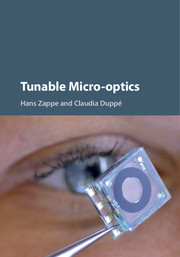Book contents
- Frontmatter
- Dedication
- Contents
- List of contributors
- List of acronyms
- Part I Introduction
- Part II Devices and materials
- Part III Systems and Applications
- 11 Characterization of Micro-optics
- 12 Photonic Crystals
- 13 MEMS Scanners for OCT Applications
- 14 Liquid Crystal Elastomer Micro-optics
- 15 Adaptive Scanning Micro-eye
- 16 Hyperspectral Eye
- 17 Plenoptic Cameras
- Index
- References
11 - Characterization of Micro-optics
from Part III - Systems and Applications
Published online by Cambridge University Press: 05 December 2015
- Frontmatter
- Dedication
- Contents
- List of contributors
- List of acronyms
- Part I Introduction
- Part II Devices and materials
- Part III Systems and Applications
- 11 Characterization of Micro-optics
- 12 Photonic Crystals
- 13 MEMS Scanners for OCT Applications
- 14 Liquid Crystal Elastomer Micro-optics
- 15 Adaptive Scanning Micro-eye
- 16 Hyperspectral Eye
- 17 Plenoptic Cameras
- Index
- References
Summary
Introduction
In today's world of information processing, the role of optics and opto-electronics is expected to become increasingly important as the performance of communication, processing, sensing and display technologies is continuously evolving. Making these photonics technologies faster, less power consuming and smaller requires at the same time the introduction of parallelism, integration and miniaturization. As a result, high-quality, high-precision and low-cost micro-optical components are becoming indispensable components. Moreover the introduction of tunable micro-optics provides new degrees of freedom for the system design and, therefore, also for the functionality. It allows solutions which are not possible with purely conventional optics, such as the integration of different functionalities. Hence, it reduces the additional mechanical assembly cost as required in conventional optics.
Tunable optical lenses in particular are becoming important optical devices for a wide variety of applications ranging from biology to laser material processing, machine vision, microscopy, ophthalmology and mobile-phone cameras (Casut 2013). Among others, their foremost advantage is the possibility to have variable focusing without mechanical translation (Commander et al. 2000). The tunability can be effectively used to obtain a different radius of curvature and consequently a varying optical power. In traditional optical designs, the focal length is changed by mechanical translation of the entire optical lens system which requires expensive mechanical actuators. With tunable lenses, such systems quickly become more compact. On top, the number of required lenses may often be reduced, too. Therefore the overall system can be designed with both an improved robustness and less weight.
Over the last fifteen years several research groups and industrial research labs have been focusing their attention on the development of fabrication techniques for tunable optics. A broad spectrum of tunable micro-optical components using a wide variety of physical effects has been proposed and demonstrated (Friese et al. 2007). Depending on the state of the material and the tuning mechanism, they can be classified as thermally tunable solid state lenses (Lee et al. 2006), liquid crystal tunable lenses (Ren et al. 2007, Kim et al. 2014) and mechanically tunable (Ren et al. 2006) or electrically tunable (Shian et al. 2013) liquid lenses. Different types of these tunable lenses are already commercially available (Berge & Peseux 2000). Chapter 5 provides a more detailed overview of tunable lenses.
- Type
- Chapter
- Information
- Tunable Micro-optics , pp. 265 - 292Publisher: Cambridge University PressPrint publication year: 2015



